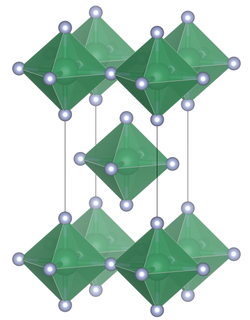 Unit cell of niobium(IV) fluoride. | |
| Names | |
|---|---|
| IUPAC name Niobium(IV) fluoride | |
Other names
| |
| Identifiers | |
| CAS Number | |
| 3D model (JSmol) | |
| ChemSpider | |
| PubChem CID | |
| CompTox Dashboard (EPA) | |
InChI
| |
SMILES
| |
| Properties | |
| Chemical formula | NbF4 |
| Molar mass | 168.9 g/mol |
| Appearance | black solid |
| Melting point | 350 °C (662 °F; 623 K) (decomposes) |
| Structure | |
| Crystal structure | tetragonal |
| Point group | I4/mmm |
| Lattice constant | a = 4,0876(5) Å, c = 8,1351(19) Å |
| Coordination geometry | Nb |
| Except where otherwise noted, data are given for materials in their standard state (at 25 °C , 100 kPa).
| |
Niobium(IV) fluoride is a chemical compound with the formula NbF4. It is a nonvolatile black solid.
Properties
NbF4 absorbs vapor strongly and turns into NbO2F in moist air. It reacts with water to form a brown solution and a brown precipitate whose components are unknown. It is stable between 275 °C and 325 °C when heated in a vacuum. However, it disproportionates at 350 °C rapidly to form niobium(V) fluoride and niobium(III) fluoride:
- 2 NbF4 → NbF5 + NbF3 (at 350 °C)
Structure
Niobium(IV) fluoride adopts a crystal structure analogous to that of tin(IV) fluoride, in which each niobium atom is surrounded by six fluorine atoms forming an octahedron. Of the six fluorine atoms surrounding a single niobium atom, four are bridging to adjacent octahedra, leading to a structure of octahedra connected in layers.
References
- ^ Bandemehr, Jascha; Conrad, Matthias; Kraus, Florian (29 July 2016). "Redetermination of the crystal structure of NbF4". Acta Crystallographica Section E. 72 (8): 1211–1213. doi:10.1107/S2056989016012081. PMC 4971875. PMID 27536416.
- 张青莲 (1981). 无机化学丛书. Beijing: Science Press. p. 323. ISBN 7-03-002238-6.
| Niobium compounds | |||
|---|---|---|---|
| Niobium(II) | |||
| Niobium(III) | |||
| Niobium(IV) | |||
| Niobium(V) |
| ||